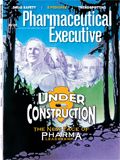Professional Promotion Through Patient Understanding
Pharmaceutical Executive
Though it may sound paradoxical, the most effective deployment of a patient-feedback program is within a pharmaceutical brand's professional promotions
Far too often, physicians receive feedback about a medication they are prescribing only when the drug is working poorly or not at all. But what about when a drug is doing its job? How often do doctors hear from their patients about the positive aspects of their treatment? Unless the patient has a follow-up visit already scheduled, the usual answer is never.

Paul LeVine
So what's the problem? Query a few physicians and you'll generally hear the same refrain: "Well, if I haven't heard from the patient, I assume he's OK" or "Most of the time, the patient will call me if there's a problem." This asymmetry of information is known more colloquially as "no news is good news." And while it may serve physicians reasonably well, this way of thinking does nothing for pharmaceutical companies looking for feedback about their drug promotions.
The Role of Patient Feedback
One solution to this problem is to use patient-feedback programs to deliver key product messages to physicians. Often these approaches are offered as customer-relationship-management programs or other consumer-based initiatives that offer drug manufacturers real-world data about the use of their products. But there is one key problem with this approach: These initiatives almost never provide consumer/patient feedback to the prescribing physicians. These programs usually include surveys of patients, some educational material, and targeted mailings to patients—but they never make the link back to the person who controls the prescribing.
Though it may sound paradoxical, the most effective deployment of a patient-feedback program is within a pharmaceutical brand's professional promotions activities.

Jeanne Zucker
Here's how a patient-feedback program should work: Pharma sales reps invite physicians to participate in the program. It is introduced as a hassle-free way to receive direct feedback from their patients about a particular brand of prescribed treatment. Once the physicians have signed up, they are provided with material to distribute to patients. When the medication is first prescribed to a patient, the physician encourages the patient to participate in the program and provide feedback about his or her experience. The patient takes a baseline survey to establish his prior medication use, symptom assessment, and condition awareness. He then will take one or more follow-up surveys, which assess his experience with the newly prescribed treatment. The design and scheduling of the surveys are aligned to focus on the key attributes of the product. An individual patient report is delivered to the physician immediately and provides the physician with comparative survey responses. Ideally, the report is discussed with the patient at a follow-up appointment—but even if not, the information about the patient's treatment experience has been provided to the physician.
If constructed correctly, a patient-feedback program offers two distinct advantages: First, it leverages the academic detail that reps are providing about the product, thereby extending the influence, and second, it "supercharges" the effect by tying the key product attributes to that physician's own patients—thereby making the product messaging highly personal and relevant.

Average NRx Lift
A Midcourse Correction
Patient-feedback programs can be implemented at any time during the product life cycle. The following is an example of a feedback program established as part of a midcourse correction.
A manufacturer was having a hard time penetrating a competitive class within the sphere of central nervous system treatments. The product launched with the expectation that its different mechanism of action would beat the market leader, and indeed, the product had some distinct advantages: faster clearance, no residual effects, and greater flexibility of use. However, it had one major disadvantage—a shorter duration of effect.
Patients and physicians were disappointed with the product's performance and the sales force quickly lost confidence in its selling messages. Consequently, the brand team dove into a repositioning effort that focused on helping physicians identify the right patient type for the product. They accomplished this goal by using a feedback program that incorporated an in-office screening questionnaire designed by physician thought leaders. The screening tools were provided to physicians by sales reps and aided the physicians in identifying the ideal patients for the medication. Physicians then encouraged these patients to participate in surveys about their treatment experience.

A recent study found that new prescriptions saw a boost when product messaging was combined with patient feedback
Feedback reports informed the physician about the patient's pre-and post-medication experience. Program data were aggregated to show practice-level response information as well as regional and national summaries, and to highlight the different patient experiences for each of the patient types.
Because the reports offered aggregated data in conjunction with individual data, physicians received reinforcement about the product at both the 1-to-1 level and the summary level. As a result, physicians were able to match appropriate patients to the product. After nine months of this correction, the brand team saw a 45 percent lift in new prescriptions (NRx) for the product among physicians who had been engaged in the initiative relative to the unexposed matched control physicians.
Charting the Course
This example isn't the only proof that patient feedback works. IMS Health recently studied the impact of building product messaging in conjunction with direct feedback programs in a variety of therapeutic classes (see "Average NRx Lift," left). Encompassing more than 20 feedback programs conducted over the past three years and involving more than 150,000 MDs, the study showed that this approach generates an NRx lift of almost 40 percent overall—incremental to a baseline of unexposed physicians. However, the study revealed even more startling information.
First, consider that 27.8 percent of the NRx lift resulted from the delivery of product messaging only. This statistic represents physicians who are exposed only to the first part of a patient-feedback program, namely the key product messages. For these physicians, the presentation of these messages alone effectively created lift for the product relative to a matched control group of unexposed physicians. In many ways, this is a promotional fail-safe: If a sales rep is not able to encourage a physician to test the product on his or her own patients, the company will still be able to convey and to reinforce the key messages via the feedback program.
However, it is in the circumstance where those key messages get tied directly to an individual patient that the really significant lift develops. The study reported a 90.9 percent lift for physicians exposed to both the direct product messages and the individual feedback. In other words, it doesn't take a lot to shift the demand curve when you marry the potency of the product's key messages with the specificity of an individual patient.
Paul LeVine is vice president, analytic services at InfoMedics. He can be reached at plevine@infomedics.com
Jeanne Zucker is senior vice president, strategic business development at InfoMedics. She can be reached at jzucker@infomedics.com
The Misinformation Maze: Navigating Public Health in the Digital Age
March 11th 2025Jennifer Butler, chief commercial officer of Pleio, discusses misinformation's threat to public health, where patients are turning for trustworthy health information, the industry's pivot to peer-to-patient strategies to educate patients, and more.
Navigating Distrust: Pharma in the Age of Social Media
February 18th 2025Ian Baer, Founder and CEO of Sooth, discusses how the growing distrust in social media will impact industry marketing strategies and the relationships between pharmaceutical companies and the patients they aim to serve. He also explains dark social, how to combat misinformation, closing the trust gap, and more.
